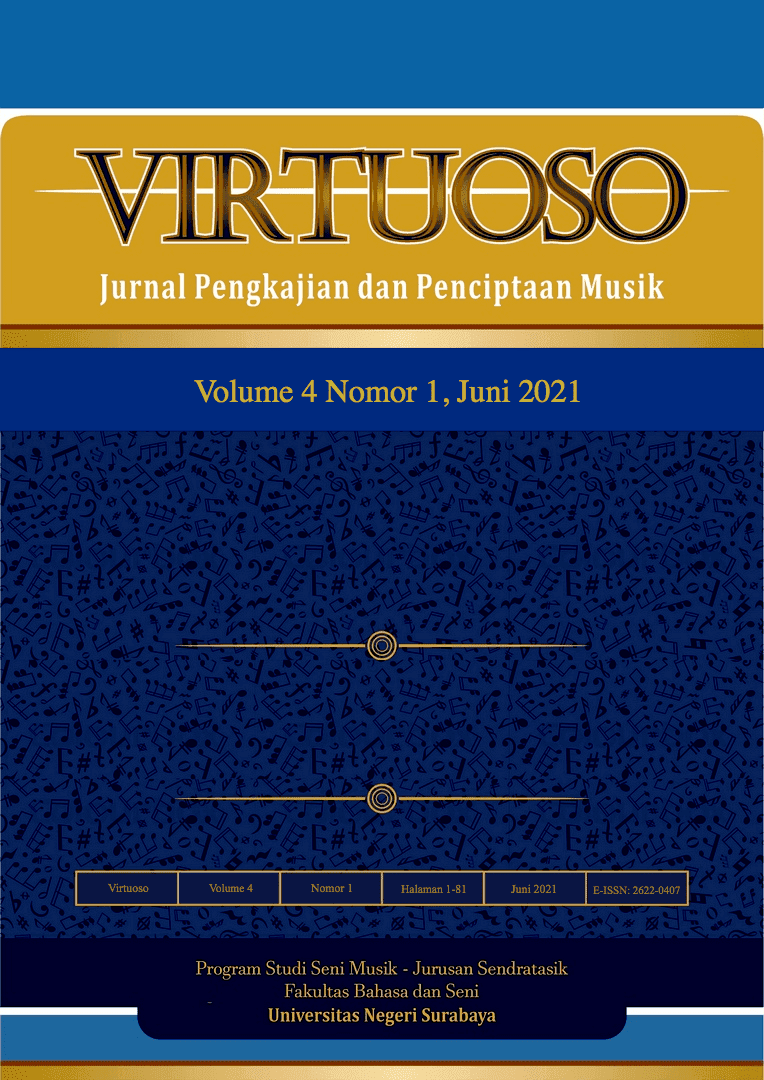Diversitas Pendidikan Multidimensional dalam Pertunjukan Kentongan Bambu Laras Banyumas Jawa Tengah
Main Article Content
Abstract
This study aims to identify the Kentongan Bambu Laras show and explore the contextualization of educational diversity in the Kentongan Bambu Laras performance. This study uses a qualitative method to recontextualize educational diversity in Kentongan Bambu Laras, Patikraja Village, Patikraja District, Banyumas Regency, Central Java. Data collection techniques include observation, interviews, documentation, and literature study. The data obtained were analyzed with a musicological approach used to analyze the form of Kentongan Bambu Laras performance from how to play and form music (form) and organology (instrumentation). The results showed that the value of honesty, discipline value, hard work value, and creative value were found in the Kentongan Bambu Laras performance. Furthermore, the recontextualization of multidimensional education lies in the instrumentation and complexity of the performances to develop physical or motor skills, perceptual, intellectual, emotional, social, creativity.
Downloads
Article Details

This work is licensed under a Creative Commons Attribution-NonCommercial-ShareAlike 4.0 International License.
The copyright of the received article once accepted for publication shall be assigned to the journal as the publisher of the journal. The intended copyright includes the right to publish the article in various forms (including reprints). The journal maintains the publishing rights to the published articles.
References
Adom, D. (2019). The place and voice of local people, culture, and traditions: A catalyst for ecotourism development in rural communities in Ghana. Scientific African, https://doi.org/10.1016/j.sciaf.2019.e00184
Allen, R. (2008). The Anthropology of Art and the Art of Anthropology - a Complex relationship (Issue March). University of Stellenbosch.
Bahatmaka, A., & Lestari, W. (2012). Fungsi Musik Dalam Kesenian Kuntulan Kuda Kembar Di Desa Sabarwangi Kecamatan Kajen Kabupaten Pekalongan Sebagai Sarana Integrasi Sosial. Catharsis: Journal of Arts Education, 1(2).
Banoe, P. (2003). Kamus Musik. Kanisius.
Bhabha, H. K. (1994). The Location of Culture. Routledge.
Denzin, N. K., & Lincoln, Y. S. (Eds.). (2013). Collecting and Interpreting Qualitative Materials (4th ed.). SAGE Publications.
Dewey, J. (1980). Art as Experience. Perigee Books.
Dubowsky, J. C. (2016). Intersecting Film, Music, and Queerness. Palgrave Studies in Audio-Visual Culture Series. https://doi.org/10.1057/9781137454218
Graham, G. (1997). Philosophy of the Art. Routledge.
Hall, S. (2002). Representations: Cultural Representations and Signifying Practices. Sage Publications.
Iryanti, V. E., Lestari, W., & Bisri, M. H. (2021). Textual Study of Sandul Performance Candigaron Village Sumowono District Semarang Regency. SSRN Electronic Journal. https://doi.org/10.2139/ssrn.3800633
James, K., & Sternberg, R. J. (2010). The Cambridge Handbook of Creativity. Cambridge University Press.
Kattsoff, L. O. (2004). Pengantar Filsafat (Soemargono-terj (Ed.)). Tiara Wacana Yogya.
Kearns, A. J. (2019). The ethical demand in teaching and learning. Teaching and Teacher Education, 86. https://doi.org/10.1016/j.tate.2019.07.004
Ki Hadjar Dewantara. (2004). Karya Ki Hadjar Dewantara Bagian I: Pendidikan. Majelis Luhur Persatuan Taman Siswa.
https://doi.org/10.1111/j.1469-5812.2005.00102.x
Lestari, W., & Barus, S. S. (2021). Budhe Centil Cross Gender Dance Hori Art & Entertainment Yogyakarta as Breakthrough Forms of the Z Generation. SSRN Electronic Journal. https://doi.org/10.2139/ssrn.3800610
Lune, H., & Berg, B. L. (2017). Qualitative Research Methods for the Social Sciences (Ninth edit). Pearson.
https://doi.org/10.1016/j.cag.2005.09.001
Miles, M. B., Huberman, A. M., & Saldana, J. (2018). Qualitative Data Analysis: A Methods Sourcebook (4th ed.). Sage Publications.
Muzaffar, I., & Otero-Pailos, J. (2015). Preservation and Globalization. Future Anterior: Journal of Historic Preservation, History, Theory, and Criticism, 9(1). https://doi.org/10.1353/fta.2012.0007
Noland, C. (2009). Agency & Embodiment: Performing Gestures/Producing Culture. Harvard University Press.
Prier, K.-E. (1989). Ilmu Harmoni. Pusat Musik Liturgi.
Rutter, M., & Garmezy, N. (1983). Developmental Psychopathology. In Handbook Of Child Psychology (4th ed.). Wiley.
Sampurno, M. B. T., Prabandari, Y. S., & Marianto, M. D. (2020). Theoretical Exploration of Art Therapy and Education for Autistic Children. International Journal of Indonesian Education and Teaching (IJIET), 4(2). https://doi.org/10.24071/ijiet.2020.040209
Sampurno, T. (2015). Seni, Melukis, dan Anak Autis: Penanganan dan Pengembangan melalui Seni dan Cara Mengevaluasi Karya Anak Autis. Psikosain.
Sasongko, W. S. (2017). Kreativitas Musik pada Grup Kentongan Adiyasa di Kabupaten Banyumas. Seni Musik Unnes, 6(2), 66-80.
Shkedi, A. (2019). Introduction to Data Analysis in Qualitative Research. Springer International Publishing.
https://doi.org/10.1177/0002716208320043
https://doi.org/10.1163/9789004253698

